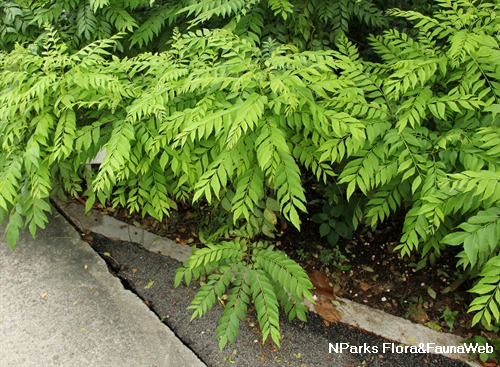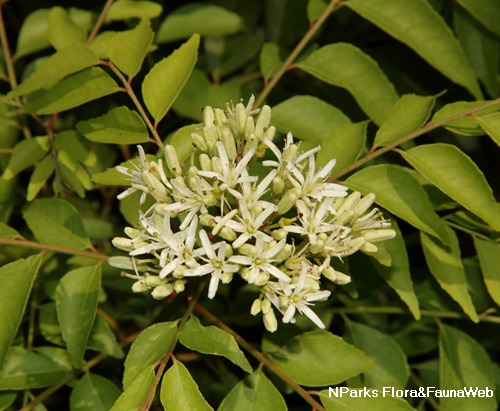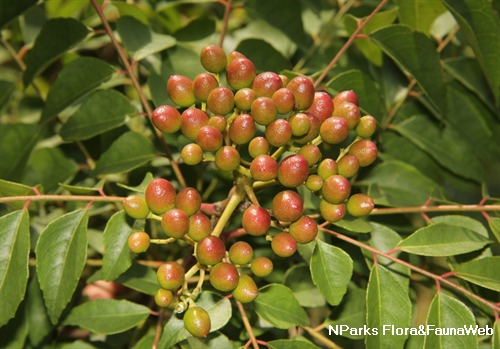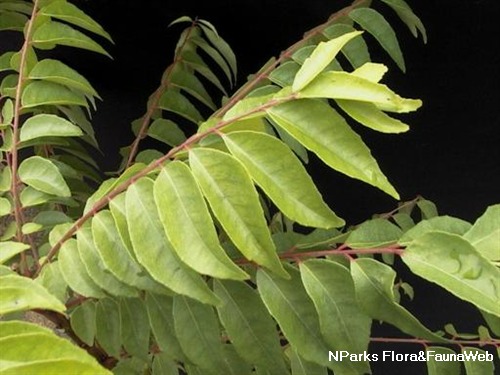
Back
Bergera koenigii L.
| Family Name: | Rutaceae |
| Synonyms: | Murraya koenigii (L.) Spreng. |
| Common Name: | Curry Leaf Tree, Daun Kari, Indian Curry Tree, Curry Bush, Karapincha, Karwa Pale, Garupillai, Kerupulai, 咖哩叶, 调料九里香, 麻绞叶 |
Name
Classifications and Characteristics
| Plant Division | Angiosperms (Flowering Seed Plants) (Dicotyledon) |
|---|---|
| Plant Growth Form | Shrub, Tree |
| Lifespan (in Singapore) | Perennial |
| Mode of Nutrition | Autotrophic |
| Plant Shape | Shrubby |
| Maximum Height | 2.5 m |
Biogeography
| Native Distribution | India to Indochina |
|---|---|
| Native Habitat | Terrestrial |
| Preferred Climate Zone | Tropical |
| Local Conservation Status | Non-native |
Description and Ethnobotany
| Growth Form | Shrub up to 2.5 m tall. |
|---|---|
| Foliage | Compound, odd-pinnate 30 cm-long leaves are composed of 11-21 shiny, dark green, lance-shaped leaflets (4.9 cm long, 1.8 cm wide). Leaflet apex emarginate and base oblique, margin slightly toothed. The leaflet are attached to the rachis (leaf stalk forming the main axis of the leaf) by a 0.5 cm-long, reddish petiole in alternate to sub-opposite arrangement (leaflets single and alternating to almost paired). Leaves are highly aromatic when rubbed or crushed. |
| Stems | Stems are dark green to brown, with numerous dots. |
| Flowers | White, funnel-shaped, 5-lobed flowers have a sweet fragrance (1.1 cm wide). Flowers are arranged in clusters (called as cyme) at the terminal. |
| Fruit | Black, glossy fruits are round to oblong (1.4-1.6 cm long, 1-1.2 cm wide). Each fruit contains a single, dark green seed (11 mm long, 8 mm wide) which takes up half the volume of the fruit. The pulp is edible, rich in Vitamin C and tastes sweet. |
| Habitat | Found in moist forests, evergreen and deciduous forests. |
| Cultivation | Plant can be propagated by seed. Sow seeds immediately after harvesting (seeds are viable up to 3 weeks). |
| Etymology | Specific epithet koenigii is named in honor of Johann Gerhad Konig (Koenig) (1728 - 1785), who was a missionary and botanist in India. |
| Ethnobotanical Uses | Edible Plant Parts : Edible Leaves Food (Herb or Spice): The leaves are used to flavor and enhance aroma in Indian curries. Medicinal: The essential oil found in the leaves and seeds have antibacterial and anti-fungal activity. |
Landscaping Features
| Desirable Plant Features | Fragrant (Foliage) |
|---|---|
| Landscape Uses | Parks & Gardens, Small Gardens, Container Planting |
Fauna, Pollination and Dispersal
| Fauna Pollination Dispersal Associated Fauna | Butterfly Host Plant |
|---|
Plant Care and Propagation
| Light Preference | Full Sun |
|---|---|
| Water Preference | Moderate Water |
| Plant Growth Rate | Moderate |
| Rootzone Tolerance | Well-Drained Soils |
| Propagation Method | Seed |
Foliar
| Foliage Retention | Evergreen |
|---|---|
| Mature Foliage Colour(s) | Green |
| Mature Foliage Texture(s) | Smooth |
| Prominent Young Flush Colour(s) | Green |
| Young Flush Texture(s) | Smooth |
| Foliar Type | Compound |
| Foliar Arrangement Along Stem | Alternate, Spiral |
| Foliar Attachment to Stem | Petiolate |
| Foliar Shape(s) | Non-Palm Foliage |
| Foliar Venation | Pinnate / Net |
| Foliar Margin | Serrate / Toothed |
| Foliar Apex - Tip | Emarginate |
| Foliar Base | Oblique / Asymmetrical |
| Leaf Area Index (LAI) for Green Plot Ratio | 4.5 (Shrub & Groundcover - Dicot) |
Floral (Angiosperm)
| Flower & Plant Sexuality | Bisexual Flowers |
| Flower Colour(s) | White |
|---|---|
| Flower Texture(s) | Smooth |
| Flower Grouping | Cluster / Inflorescence |
| Flower Location | Terminal |
| Flower Symmetry | Radial |
| Individual Flower Shape | Funnelform / Funnel-shaped |
| Inflorescence Type | Cyme |
| Flowering Period | Free-Flowering |
Fruit, Seed and Spore
| Mature Fruit Colour(s) | Red, Black |
|---|---|
| Fruit Classification | Simple Fruit |
| Fruit Type | Fleshy Fruit |
| Seed Quantity Per Fruit | Few (1-5) |
Image Repository
Others
| Master ID | 944 |
|---|---|
| Species ID | 2238 |
| Flora Disclaimer | The information in this website has been compiled from reliable sources, such as reference works on medicinal plants. It is not a substitute for medical advice or treatment and NParks does not purport to provide any medical advice. Readers should always consult his/her physician before using or consuming a plant for medicinal purposes. |




_lowres.jpg)
_lowres.jpg)